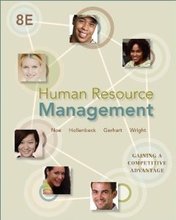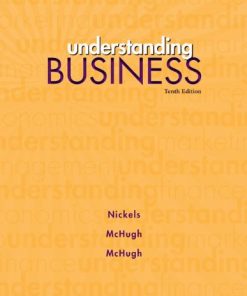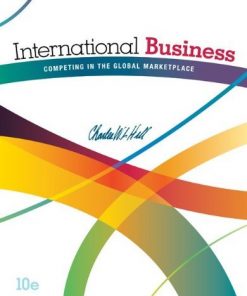Human Resource Management Noe 8th Edition Solutions Manual
$35.00
Human Resource Management Noe 8th Edition Solutions Manual
You will receive this product immediate after placing the order
Human Resource Management
Human Resource Management Noe Hollenbeck Gerhart
Human Resource Management Noe Hollenbeck Gerhart 8th
Human Resource Management Noe Hollenbeck Gerhart 8th Solutions Manual
Human Resource Management Noe 8th Edition Solutions Manual
*** YOU ARE BUYING the Solutions Manual ***
Name: Human Resource Management
Author: Noe Hollenbeck Gerhart
Edition: 8th
Type: Solutions Manual
–
–
We also faced similar difficulities when we were students, and we understand how you feel.
But now, with the Human Resource Management 8th Solutions Manual, you will be able to
* Anticipate the type of the questions that will appear in your exam.
* Reduces the hassle and stress of your student life.
* Improve your studying and also get a better grade!
* Get prepared for examination questions.
* Can save you time and help you understand the material.
This is the quality of service we are providing and we hope to be your helper.
Solutions Manual is accurate.
Prepare to receive your Human Resource Management 8th Solutions Manual in the next moment.
If you have any questions, or would like a receive a sample chapter before your purchase, please contact us at [email protected]
Human Resource Management
Human Resource Management Noe Hollenbeck Gerhart
Human Resource Management Noe Hollenbeck Gerhart 8th
Human Resource Management Noe Hollenbeck Gerhart 8th Solutions Manual
Human Resource Management Noe 8th Edition Solutions Manual
Chapter 01 Human Resource Management: Gaining a Competitive Advantage
Please click here to access the new HRM Failures case associated with this chapter. HRM Failures features real-life situations in which an HR conflict ended up in court. Each case includes a discussion questions and possible answers for easy use in the classroom. HRM Failures are not included in the text so that you can provide your students with additional real-life content that helps engrain chapter concepts.
Chapter Summary
This chapter discusses the role of the Human Resource Management (HRM) function in the corporate effort to gain a competitive advantage. The chapter first discusses the roles and skills that a human resource management department and/or managers need for any company to be competitive. The second section of the chapter identifies the competitive challenges that U.S. companies currently face, which influence their ability to meet the needs of shareholders, customers, employees, and other stakeholders. We discuss how these competitive challenges are influencing HRM. The chapter concludes by highlighting the HRM practices covered in thisand the ways they help companies compete.
Learning Objectives
After studying this chapter, the student should be able to:
1. Discuss the roles and activities of a company’s human resource management function.
2. Discuss the implications of the economy, the makeup of the labor force, and ethics for company sustainability.
3. Discuss how human resource management affects a company’s balanced scorecard.
4. Discuss what companies should do to compete in the global marketplace.
5. Identify the characteristics of the workforce and how they influence human resource management.
6. Discuss human resource management practices that support high performance work systems.
7. Provide a brief description of human resource management practices.
Extended Chapter Outline
Note: Key terms are boldface and are listed in the “Chapter Vocabulary” section.
Opening Vignette:
Starbucks: HR Practices Help Focus on the Brew, Weather the Recession and Prepare for Growth
Starbucks is Seattle- based coffee store with a mission to “inspire and nurture the human spirit. Its stores, which number 17,000 operating in the United States and 50 other countries, provide an inviting place for customers to enjoy fresh brewed coffee as well as smoothies, teas, pastries, sandwiches, salads, oatmeal, parfaits and fruit cups. The company has experienced come challenges from the economic downturn in 2007 when the recession as well as competition cut into its profits. The company had to close stores, retool practices for greater efficiency, and launch a new marketing campaign. Starbucks believes that its employees, whom it calls “partners,” are vital to its success. The company wants its partners to have coffee knowledge, product expertise, and provide excellent customer service. The company also believes in investing in its partners. It provides comprehensive health care benefits for partners who work 240 hours per quarter. Starbucks has a “total pay” package that includes programs that embrace diversity, providing all employees and their opposite-sex or same-sex partners with comprehensive health care benefits that include medical, dental, and vision care as well as tuition reimbursement, stock options, a discounted stock purchase plan, vacations and a 401(k) retirement plan. Starbucks’ CEO Howard Schultz places a high importance on partners. This is evidenced by his response to an institutional investor who, during the worst time for the company during the recent recession to consider cutting employee health care benefits. Schultz indicated he would not so do, and suggested that the investor invest elsewhere.
Discussion Questions
1. Think about the emphasis that even the face of economic challenges and stiff competition such as McDonalds’ and Dunkin Donuts, Starbucks places a heavy emphasis on treating its employees with care. Starbucks cares about knowledgeable employees, and it also training, comprehensive medical benefits as well as other benefits. Why do you think that CEO Howard Schultz is willing to persist in the provision of such benefits, even in the face of these external challenges?
Student answers may vary but certainly look for evidence that students understand the relationship between Human Resource Management practices, and business success. In particular, look for evidence that students connect Starbucks’ business model which emphasizes employee product knowledge and customer service, with the Human Resource Management practices of the company. Also, consider looking for evidence that students acknowledge that the CEO, Howard Schultz, himself is a champion for strong and effective Human Resource Management.
I. Introduction
A. Competitiveness refers to a company’s ability to maintain and¬ gain market share in its industry.
1. Competitiveness is related to effectiveness, which is determined by whether the company satisfies the needs of stakeholders (groups affected by business practices).
B. Human Resource management (HRM) refers to policies, practices and systems that influence employees’ behaviors, attitudes and performance. (See Figure 1.1)
1. Effective HRM practices have been shown to relate to company performance by contributing to employee and customer satisfaction, innovation, productivity, and development of a favorable reputation in the community in which the firm is located.
2. The HRM contribution has only recently been recognized.
II. What responsibilities and roles do HR departments perform?
A. Responsibilities that the HR department is solely responsible for include outplacement, Labor Law Compliance, record keeping, testing, unemployment compensation, and some aspects of benefit administration. (See Table 1.1).
B. Many different roles and responsibilities can be performed by the HR department depending on the size of the company, the characteristics of the workforce, the industry, and the value system of the company’s management.
C. HRM as a Business with Three Product Lines:
1. Administrative services and transactions: compensation, hiring, staffing.
• An emphasis is placed on resource efficiency and service quality.
2. Business partner services: developing effective HR systems and helping implement business plans, talent management.
• An emphasis is placed on knowing the business and exercising influence—problem solving, designing effective systems to ensure needed competencies.
3. Strategic partner: contributing to business strategy based on considerations of human capital, business capabilities, readiness, and developing HR practices as strategic differentiation.
• An emphasis is placed on knowledge of HR and of the business, competition, the market, and business strategies.
III. What competencies do HR professionals need? Figure 1.3 shows the six competencies that are needed for the HR profession.
1. Credible activist: delivers results with integrity, shares information, builds trusting relationships, and influences others, providing candid observation, taking appropriate risks.
2. Cultural steward: facilitates change, develops and values the culture, and helps employees navigate the culture.
3. Talent manager/organizational designer: develop talent, design reward systems, and shapes the organization.
4. Strategic architect: recognizes business trends and their impact on the business, evidence-based HR, and develops people strategies that contribute to the business strategy.
5. Business Ally: understands how the business makes money and the language of the business.
6. Operational executor: implements workplace policies, advances HR technology, and administers day-to-day work of maintaining people.
IV. How is the HRM function changing?
A. The amount of time that the HR function is devoting to administrative tasks is decreasing and its role as a strategic business partner, change agent, and employee advocate are increasing.
B. Advancement in technology is enhancing self-service. Self-service is the process of giving employees control of HR transactions. This allows employees to take greater responsibility for their own careers.
C. Outsourcing refers to the practice of having another company provide services.
D. Evidence-based HR refers to demonstrating that human resources practices have a positive influence on the company’s bottom line or key stakeholders.
E. In-house HR activities are likely to be performance management, employee communications, plans and strategies, and policy development and implementation.
V. The HRM Profession
1. There are many different types of jobs in the HRM profession. (See Table 1.3)
2. The primary professional organization for HRM is the Society for Human Resource Management (SHRM).
VI. Competitive Challenges Influencing Human Resource Management (See Figure 1.4)
A. The Sustainability Challenge
1. Sustainability refers to the ability of a company to survive and succeed in a dynamic competitive environment.
2. Company success is based on how well the company meets the needs of its stakeholders. Stakeholders refer to shareholders, the community, customers, and all of the other parties that have an interest in seeing that the company succeeds.
3. Several changes in the economy have important implications for human resource management. Some key statistics about the economy and the workforce are shown in Table 1.4.
4. The competition for labor is affected by the growth and decline of industries, jobs, and occupations. Competition for labor is also influenced by the number and skills of persons available for full-time work. (See Table 1.5)
a. The most significant percentage change in employment from 2004 to 2014 is expected to be home health aides and computer software engineers, applications.
b. Personal and home health care aids and home health care aids also represent the largest number of job openings.
5. Increased Value Placed On Intangible Assets and Human Capital
a. Intellectual assets refer to a type of company asset including human capital, customer capital, social capital, and intellectual capital. (See Table 1.7).
b. Knowledge workers are employees who own the intellectual means of producing a product or service.
c. Empowerment means giving employees responsibility and authority to make decisions regarding all aspects of product development or customer service.
d. As more companies become knowledge-based, they must promote and capture learning at the employee, team, and company levels.
e. A changing environment means that all employees must embrace a philosophy of learning. A learning organization embraces a culture of lifelong learning, enabling all employees to continually acquire and share knowledge.
6. Changes in the Employment Expectations
a. The need for companies to make rapid changes has played a major role in changing the employment relationship. The psychological contract describes what an employee expects to contribute and what the company will provide to the employee for these contributions.
b. In the new economy a new type of psychological contract is emerging. Companies demand excellent customer service and high productivity levels. Employees are expected to take more responsibility for their own careers, from seeking raining to balancing work and family. In exchange, employees want companies to provide flexible work schedules, comfortable working conditions, more autonomy in accomplishing work, training and development opportunities, and financial incentives based on how the company performs.
7. Concerns with Employee Engagement
a. Employee engagement refers to the degree in which employees are fully involved in their work and the strength of their job and company commitment. (See Table 1.8).
b. Employees who are engaged in their work and committed to the company they work for give companies competitive advantages (higher productivity, better customer service, lower turnover).
Evidence-Based HR: United Health Care
United Health Care is a company comprised of six businesses focused on individual, community, and state health care plans and services. The company uses employee engagement surveys to learn about the relationship between Human Resource Management practices and the company’s business strategy. When recent survey results revealed that managers’ performance, communication, and understanding of how each employee’s job contributes to business strategy, the executive vice president of human capital took action. This action included initiating personal and monthly communications with managers about how to engage employees and explain what employees can do to positively impact the business strategy. As a result, employee turnover has decreased by nine percent, rates of internal promotion have increased by 13 percent, and the rates of first year attrition have dropped by ten percent.
Class Exercise
Have the students break into small groups of three to four each, and have them discuss the following question: What specific lessons does the case of United Health Care present, about employee engagement? To what extent does it matter that employees understand how their actions and their jobs relate to the business strategy? How does the case of United Health Care, presented in this Evidence-Based HR vignette, illustrate the effects of employee engagement?
Answers could include the following:
Effective employee engagement practices communicate to employees how their actions positively contribute to the strategy of the business. When employees feel that their actions contribute to organizational strategy, they are more committed, they tend to stay longer, and they have higher aspirations for themselves at their organizations.
8. Talent Management
a. Talent management involves attracting, retaining, developing, and motivating highly skilled employees and managers.
b. Companies report that one of the most important talent management challenges they face is developing existing employees for managerial positions and attracting and retaining top level managers in leadership positions.
9. Use of Alternative Work Arrangements
a. Alternative work arrangements include use of independent
contractors, on call workers, temporary workers, and contract
company workers.
10. Demanding Work, but with More Flexibility
a. The globalization of the world economy and the development of e-commerce have made the notion of a 40-hour work week obsolete.
b. Many companies are taking steps to provide more flexible work schedules, protect employees’ free time, and more productively use employees’ work time.
B. The balanced scorecard: Measuring performance to stakeholders (See Table 1.9)
1. The balanced scorecard gives managers the opportunity to look at the company from the perspective of internal and external customers, employees and shareholders. The balanced scorecard should be used to:
a. Link human resource management activities to the company’s business strategy.
b. Evaluate the extent to which the human resource function is helping the company’s meet its strategic objectives.
C. Social Responsibility.
1. Social Responsibility is the recognition by companies that by engaging in business practices that take into account their effects on all stakeholders, they boost their image, gain access to new markets, and attract and retain talented employees.
2. Several companies such as Microsoft, Whole Foods, Nokia, Motorola, and Palm have been lauded for their socially responsible efforts.
Competing Through Sustainability
Volunteerism and Going Green are Reaping Dividends for Employees, Communities, and the Environment
Companies such as General Mills, pharmaceutical company Novartis, and General Electric are becoming increasingly socially conscious through sustainability efforts as well as volunteerism. General Mills’ Chairman and CEO wants the company to be the most socially responsible consumer food company in the world. For example, Finance and Information Technology employees from General Mills Canada picked more than 7000 apples and pears as part of a teambuilding exercise, and they donated the fruit to food banks in the Niagara region of Canada. General Electric’s health care unit identified maternal and infant mortality as frequent causes of death in India and in response, it developed a product that provides heat for cradles. Novartis supports REPSSI, which is an African-based philanthropic organization that provides emotional and financial support for children who lose their parents or guardians to AIDS.
Discussion Question
1. What are the benefits for these corporations who encourage volunteerism? Can you identify an organization in your own community that engages in socially responsible practices such as encouraging employee volunteerism?
Student responses may vary, but look for evidence that students understand the definition of social responsibility and look for specific responses that could include the improvement in the health of employees through better diet and exercise and the increased well-being of volunteers. Other responses could include the strengthening of the company’s tie to its community that results in a positive reputation.
C. Customer Service and Quality emphasis
1. Customer excellence requires attention to product and service features as well as to interactions with customers.
2. Total Quality Management can be defined as “a cooperative form of doing business that relies on the talents and capabilities of both labor and management to continually improve quality and productivity using work teams.” This is one strategy companies are currently using.
a. The TQM movement has alerted management to the key role HRM plays in the achievement of quality.
b. The Malcolm Baldrige National Quality Award was established by President Reagan to publicize successful quality strategies. (See Table 1.10 for the award criteria)
Example: Two of the 2007 Baldridge award winners were Sharp HealthCare of San Diego, California and PRO-TEC Coating company of Leipsic, Ohio. Sharp HealthCare is a not-for-profit organization that employs 14,000 staff members, 2600 affiliated physicians, operates seven hospitals, three medical groups, 19 outpatient clinics, and manages its own health insurance plan. Sharp HealthCare meets and exceeds patients expectations by providing high-quality health care. PRO-TEC Coathing Company is an industry leader in developing high-strength stell that inhibits corrosion. From 2002-2005, the company produced an estimated 85% of the high-strength stell supply in the U.S. Their employees work in self-directed teams and are empowered to use continuous improvement processes to fix problems as they occur.
c. The ISO 9000:2000 standards were developed by the International Organization for Standardization in Geneva, Switzerland. ISO 9000 is the name of a family of standards (ISO 9001, ISO 9004) that includes requirements such as how to establish quality standards and document work processes to help workers understand quality system requirements. ISO 9000:2000 has been adopted as a quality standard in nearly 100 countries.
d. The Six Sigma process refers to a system of measuring, analyzing, improving, and then controlling processes once they have been brought within the narrow Six Sigma quality tolerances or standards. The objective of Six Sigma is to create a total business focus on serving the customer—that is, deliver what customers really want when they want it.
Be the first to review “Human Resource Management Noe 8th Edition Solutions Manual” Cancel reply
Related products
Solution Manual
Solution Manual
Understanding Business Nickels 10th Edition Solutions Manual
Solution Manual
Solution Manual for Introduction to Electrodynamics, 4/E 4th











Reviews
There are no reviews yet.